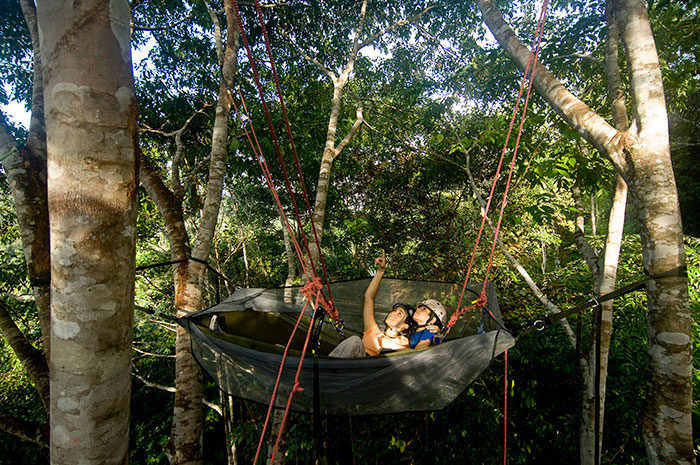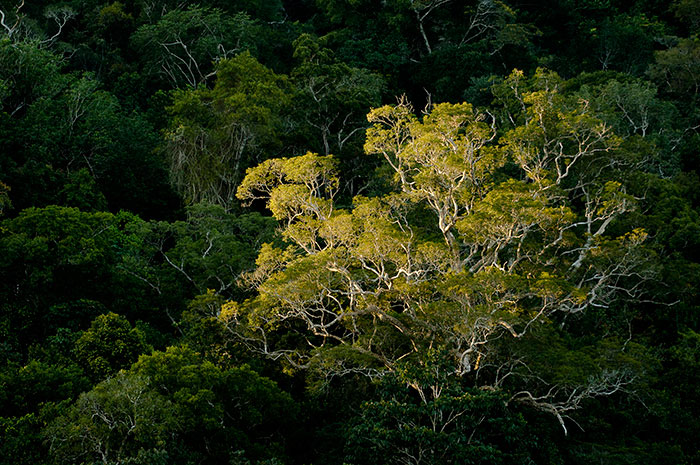
Explore the canopy or sleep in the trees with Tropical Tree Climbing. Photo © Leonide Principe.
When planning a great Amazonian eco-adventure, foreign travelers inevitably conjure up images of gliding down one of the region’s thousands of river tributaries by boat, or thwacking through the dense tangled jungle on foot. Few are aware that there exists an equally adventurous way to discover the world’s largest and most famous rainforest: climbing to the very top of it. Although still somewhat of a niche activity, tree climbing is emerging as one of the most novel and eco-friendly ways to explore and immerse oneself in the Amazon rainforest.Although still somewhat of a niche activity, tree climbing is emerging as one of the most novel and eco-friendly ways to explore and immerse oneself in the Amazon rainforest. Once outfitted with ropes, a harness, and other climbing gear, you can spend a couple of hours ascending gigantic trees, taking breaks to contemplate and photograph nature, and dangle in a deliciously suspended state 200 feet above the forest floor. When suddenly – and spectacularly – you emerge into the canopy and gaze out upon a vast ocean of lush foliage, your first reaction will be awe. Your second reaction will be an emphatic refusal to climb back down to earth.Tropical Tree Climbing, an eco-operator based in the rainforests surrounding Presidente Figueiredo, a town 120km from the Amazonian capital of Manaus, offers multi-day excursions in addition to the standard 8-hour climb. The most fantasy-satiating options involve “canopy camping” – i.e. spending the night in the treetops, where you’ll be lulled to sleep by the dream-inducing vision of a star-flooded firmament and then awakened by a raucous symphony of tropical birds heralding the sunrise.
“For many people, climbing a tree already conjures up happy memories of childhood,” says co-founder of Tropical Tree Climbing, Vanessa Mariño. “However, no matter what your age, spending the night in the treetops of the rainforest is truly an unforgettable experience that will stay embedded in your memory for the rest of your life.” A Venezuelan artist and environmentalist, Mariño owns and runs the small sustainable outfit with Leonide Principe, a Franco-Italian photographer who specializes in documenting Amazonian nature – particularly from the privileged perch of the jungle canopy.

Photo © Leonide Principe.
Apart from gaudily feathered birds (toucans, parrots, and woodpeckers), and plushly furred monkeys (howlers, red-faced spider monkeys, and robust capuchin monkeys), the treetops are home to “Amazon air plants.” One of the most unusual of these is the Acacallis cyanea, a rare and surreally blue-hued orchid whose name alludes to the beautiful Greek nymph who seduced Apollo, as the flower has done to countless European 19th- and 20th-century botanists.
Once the climb is over, ropes and other equipment are taken down, returning the tree to its original state.“We’ve actually created an entire map of available trees [for climbing] – all of them native species such as samauma and angelim,” says Mariño. “Before choosing a tree, we examine the configuration of branches and inspect the soil around the tree as well as the trunk, leaves, fungi. We make sure there are no nests of insects such as spiders and wasps. After a tree has been inspected and approved, we carry out trial climbs and then install the ropes, so that everything is ready for climbers. Of course, a decisive element in selecting a tree is the splendor of the view gleaned from above.”Once the climb is over, ropes and other equipment are taken down, returning the tree to its original state. Indeed, tree climbing is one of the lowest-impact recreational activities in which an Amazonian adventurer can indulge, not to mention one of the most highly sustainable, as the activity generates jobs and income for locals while promoting the conservation of the Amazon rainforest.
As Mariño points out, “Climbing an Amazonian tree offers a unique opportunity to reconnect and integrate with nature from the point-of-view of birds, monkeys, and so many other species that live at the forest’s summits.” From the jungle’s lofty emerald heights, one is able to experience the ultimate treedom.
Learn more at the Tropical Tree Climbing website.